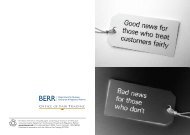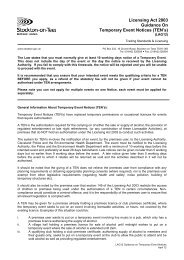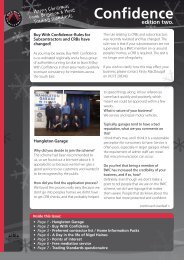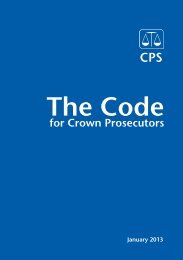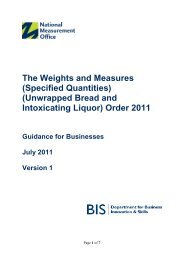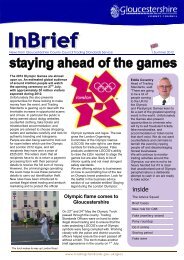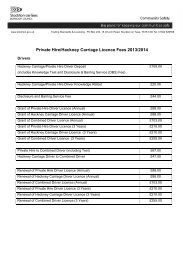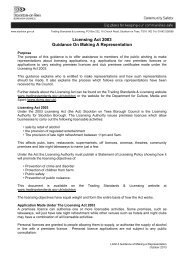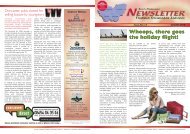Body Piercing Aftercare Advice Sheet - Trading Standards Institute
Body Piercing Aftercare Advice Sheet - Trading Standards Institute
Body Piercing Aftercare Advice Sheet - Trading Standards Institute
You also want an ePaper? Increase the reach of your titles
YUMPU automatically turns print PDFs into web optimized ePapers that Google loves.
<strong>Body</strong> <strong>Piercing</strong><br />
<strong>Aftercare</strong> <strong>Advice</strong> <strong>Sheet</strong><br />
Premises Name:<br />
Premises Address:<br />
Telephone Number:<br />
Practitioner: (Print Name)<br />
Date of Treatment:<br />
Site of Treatment:<br />
This advice sheet is given as your written reminder of the advised aftercare for your new piercing.<br />
Getting a new piercing involves breaking the skin surface so there is always a potential risk for<br />
infection to occur afterwards. Your piercing should be treated as a wound initially and it is<br />
important that this advice is followed so that the infection risk can be minimised.<br />
Minimising Infection Risk Guidance Tips:<br />
• Most piercings will bleed at first but this should stop within a few minutes. Gentle pressure on<br />
or around the pierced site will slow bleeding, but if it is excessive or persists then immediate<br />
medical advice should be sought;<br />
• Remember, all pierced regions will tend to swell immediately after treatment, and the item of<br />
jewellery you have inserted will be designed to accommodate this. Tongue piercings may swell<br />
to the limit of the inserted bar, and this can be reduced by rinsing the mouth with iced water;<br />
• If the jewellery becomes too tight because of swelling, see your body piercer immediately. If,<br />
however, you have a tongue piercing and begin to experience neck pain or problems with<br />
swallowing, contact a medical practitioner immediately or go direct to your local Accident<br />
and Emergency Department;<br />
• Always wash and dry your hands before and after any essential handling of a newly pierced<br />
site, e.g. cleaning of the area;<br />
• Avoid unnecessary toughing, scratching or picking of the newly pierced site to reduce the risk<br />
of introducing infection. In particular, avoid using fingernails to handle jewellery, as the<br />
underside of nails are more likely to introduce infection to the pierced site;<br />
• After removing any initial dressing applied by the piercer, clean the piercing twice a day if<br />
possible – the use of boiled water, allowed to cool, and clean gauze or other non-disintegrating<br />
cotton wool swabs is best for this. Sterile (normal) saline purchased in sachets from you<br />
pharmacist is also suitable for this;<br />
• Gently soak off and wipe away any crusty formations at the wound site – do not pick them off;<br />
• Avoid applying hot cleaning solutions or surgical spirit on the treated area as they can damage<br />
delicate healing skin;<br />
• If possible, shower rather then bathe whilst the piercing is healing so that unnecessary water<br />
submersion is avoided;<br />
• Pat dry the pierced area after cleaning – do not rub as this could snag jewellery and tear<br />
delicate healing tissue;
• Do not use skin products on the treated area that have not been recommended by your<br />
operator or are not intended for open wound healing. There is generally no need to use any<br />
other skin antiseptic products and you should not share skin products with others;<br />
• Avoid swimming, sun beds and sun bathing until your new piercing is fully healed, as direct<br />
sunlight/chlorine can interact with treated site causing skin irritation and inflammation;<br />
• Try to wear loose, cotton clothing to minimise rubbing and irritation to a newly pierced site, and<br />
in general try and keep a new piercing as dry and exposed as possible;<br />
• Always keep a new piercing covered and protected if working in a dirty, dusty or oily<br />
environment – a non-adhesive dressing secured with dermatological tape is best;<br />
• Only every change your jewellery as directed by your operator, and ensure any new jewellery<br />
you buy is of good quality and is from a reputable dealer; and<br />
• If you have any problems/queries, please contact your operator initially. He/She will refer you<br />
onto your GP if there are signs of adverse reaction/infection.<br />
For <strong>Body</strong> <strong>Piercing</strong>, expected (complete) healing times are difficult to predict because individuals<br />
healing abilities vary, but all clients should be told what to expect. The healing time is the time<br />
required for the jewellery “tunnel” to become dry and healed after the initial tissue damage.<br />
Guidelines are scarce in this area, but those provided below originate from the US Association of<br />
Professional Piercers:<br />
• Ear lobe, eyebrow and nasal septum:<br />
6 to 8 weeks<br />
• Ear (cartilaginous region) and nostril:<br />
2 months to 1 year<br />
• Tongue: 4 to 8 weeks<br />
• Lips and cheeks: 6 to 12 weeks**<br />
• Genital (female and male) including inner labia, clitoral hood: 4 to 12 weeks<br />
• Nipple, scrotum, outer labia:<br />
2 to 6 months<br />
• Navel and ampallang (a transverse penile piercing);<br />
4 months to 1 year<br />
** Chewing gum should be avoided while oral piercings are healing. Newly pierced tongue regions can be<br />
gently cleansed with a clean, soft toothbrush and toothpaste, in order to remove any coating around the site.<br />
Half strength mouth wash – diluted with tap water – should be used twice daily after tongue piercings, and<br />
additionally after eating, drinking or smoking.



